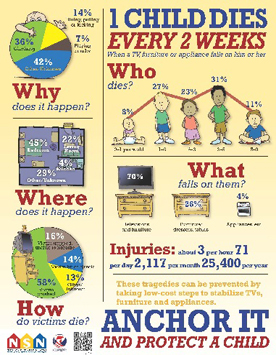Children love to climb, and regardless of how many times we tell them not to, they’re going to climb anyway. As soon as your back’s turned, they’ll climb stairs, on the sofa, the dog or furniture. Tragically, climbing on furniture is how thousands of children each year are injured or killed.
Recently, a father in South Carolina was convicted of child neglect after a dresser fell on and killed his 18 month-old-child. Last February, in my hometown of Macon, Georgia, a 17-month old died when a dresser with a TV on top of it fell over on the toddler. Sadly, these stories are not isolated events. Every day children are accidentally injured or killed from a falling television, furniture or appliance.

According to the Consumer Product Safety Commission, between 2000-2011, there were 294 children who died when furniture, a TV, or appliance fell on top of them. That’s one child every 2 weeks. As shown in the following chart, there are 25,400 children injured every year from falling furniture, which averages out to be 71 injuries per day.
Having raised two children, I recall warnings about the dangers of kids climbing on furniture, so I secured furniture that appeared wobbly or top heavy, but mistakenly, I did not secure what I thought to be short, sturdy furniture. Surprisingly, furniture you think wouldn’t tip, can, and it can happen quickly, even with parents or babysitters in the house. Luckily, I have no personal incident to speak of, but there are many devastating stories of people who didn’t secure what they thought to be “safe” furniture, and their child was injured or killed because of it. Please take the time to read about one such heart-rending loss and the resourceful information at meghanshope.org. I also urge you to watch a brief CPSC video that shows how easily furniture and TVs can tip over.
There are things you can do to prevent such accidents from happening:
- Secure furniture (dressers, bookshelves, plant stands, TV stands, etc.) to the wall or floor. You can buy security latches in the baby department at stores like Walmart or Target or online at Amazon.com. They cost about $5.00 and it takes about 15 minutes to attach them.
- Place TVs or computer monitors on sturdy, low bases, and anchor the furniture, or anchor the TV on top of the base, making sure to push the TV as far back as possible.
- Make sure any cables or cords are out of reach of children, as these can be tripped over or used to pull the TV off the stand.
- Make sure free standing appliances (i.e., stoves, mini-fridges, microwaves, air conditioners) are secured with anti-tipping latches.
- Think about the weight, size and stability of other objects in your home. If anything could fall and injure a child it should be secured.
These tragedies can happen to anyone, anytime. Please take a few short minutes to secure items in your home and homes where your child will be staying. Make sure heavier items are on the bottom of shelves, drawers are secured, and toys are not placed high where children would want to crawl up to retrieve them. Please spread the word by sharing the Anchor It and Protect A Child flier published by the CPSC. You can download or share a copy here.
 If you or a family member go to an Emergency Room in Georgia, what level of care do you expect to receive? Some lawyers for doctors and hospitals say that you are only entitled to receive something called “slight care” which is lower than the historical standard of “ordinary care” or reasonable care” that we’ve operated under for many years in Georgia medical malpractice cases.
If you or a family member go to an Emergency Room in Georgia, what level of care do you expect to receive? Some lawyers for doctors and hospitals say that you are only entitled to receive something called “slight care” which is lower than the historical standard of “ordinary care” or reasonable care” that we’ve operated under for many years in Georgia medical malpractice cases.